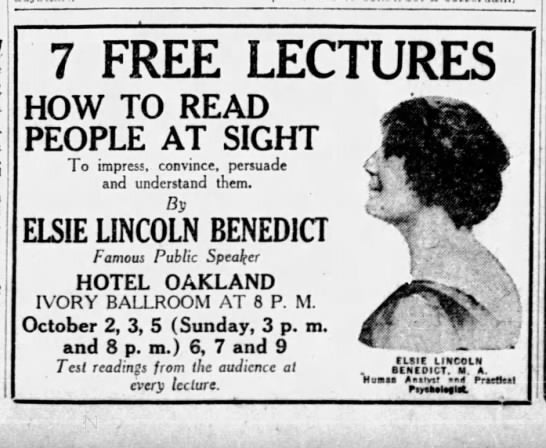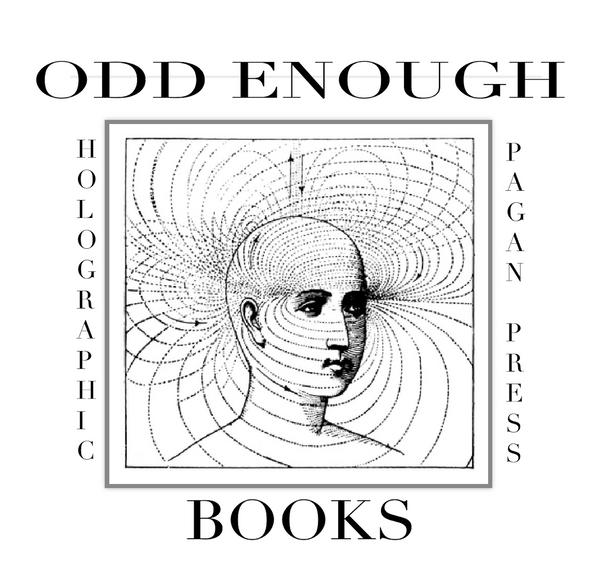
Elsie Lincoln Benedict: Visionary of the School of Opportunity and the New Thought Movement
Elsie Lincoln Benedict (1885–1970) was a formidable force in early 20th-century American intellectual and cultural life. A prolific author, popular lecturer, and feminist educator, Benedict fused psychology, self-help, and metaphysics into a practical system of self-mastery.

Through her School of Opportunity, and her many influential books, she empowered thousands—especially women—to understand their personalities, reframe their limitations, and chart paths toward greater personal freedom. Her work was deeply intertwined with the New Thought movement, drawing from its metaphysical ideals while translating them into accessible, action-oriented tools. This essay examines Benedict’s educational mission, her advocacy for women's self-realization, and her philosophical grounding in New Thought, as articulated in her major works.
The School of Opportunity: Teaching Through Typology

Benedict’s School of Opportunity was a pioneering institution devoted to what she termed “scientific character analysis.” The curriculum emphasized identifying and cultivating an individual’s innate strengths, primarily through the lens of personality. Her landmark book, How to Analyze People on Sight (1921), co-authored with her husband Ralph Paine Benedict, laid out a typology based on physical and psychological traits—dividing people into five distinct “types”: Alimentive, Thoracic, Muscular, Osseous, and Cerebral. These classifications, Benedict argued, were not merely descriptive but predictive; by understanding one’s type, an individual could align with their natural aptitudes in career, relationships, and leadership.
The School of Opportunity operationalized these ideas in the form of lectures, workshops, and reading materials, where students were taught not only to diagnose others’ personalities but to discover and articulate their own. In Human Analysis (1922), Benedict further elaborated this pedagogical method, asserting that “knowledge of human nature is the first essential in dealing successfully with any individual,” a belief central to both her teaching and her wider social vision.
Reframing Women’s Potential

Benedict’s influence on women’s intellectual and vocational self-concept cannot be overstated. At a time when women’s education was often limited to domestic arts or secretarial work, Benedict offered a framework that positioned self-knowledge as a feminist act. Her book How to Make More Money (1925) directly addressed women’s economic empowerment, urging readers to “stop selling yourself short” and “capitalize on your type.” She framed economic agency as inseparable from personal awareness and advocated for careers suited to one’s inborn characteristics—an approach that anticipated later developments in vocational psychology.
In Our Trip Around the World (1923), a travelogue filled with sociological observations, Benedict not only chronicled her global lecture tours but used them to compare gender roles across cultures. She consistently used her platform to demonstrate how women's oppression was socially constructed, not biologically determined—a stance that was radical for its time. Her ability to speak confidently on politics, culture, psychology, and business made her a living refutation of the notion that women were intellectually inferior.
New Thought Influences and the Inner World
Benedict’s work was deeply influenced by the New Thought movement, a spiritual philosophy that emphasized mental causation and the power of positive thinking. Though she rarely invoked the term “New Thought” directly, her books are steeped in its principles. In Unlocking the Sub-Conscious (1922), Benedict wrote, “Thoughts are seeds; plant the kind you wish to grow.” This aphorism typifies the New Thought ideal that the mind shapes reality—a belief she translated into accessible tools for daily life.

In How to Get Anything You Want (1929), Benedict offered step-by-step techniques for manifestation that included visualization, affirmations, and emotional conditioning. These methods echoed those of contemporaries like Wallace Wattles and Florence Scovel Shinn but were presented in Benedict’s characteristically pragmatic, psychological tone. Her version of New Thought was less mystically framed and more focused on practical success, making it especially appealing to readers eager for tangible results.

Her metaphysical beliefs were not isolated from her social mission. In Marriage—As It Is and As It Should Be (1926), she applied New Thought principles to relationships, arguing that harmony and growth were possible only when both partners were attuned to their individual purposes and capacities. Again, self-knowledge and mental discipline became tools not just for personal success, but for transforming social institutions like marriage and work.
Legacy and Historical Recovery
Elsie Lincoln Benedict was one of the most successful female public speakers of her era—reportedly addressing over three million people by 1920—and yet her legacy remains largely obscured in academic and popular histories. Her neglect likely stems from her marginal position outside formal academia, and from the hybrid nature of her work, which blended psychology, mysticism, and pedagogy in ways that defy easy categorization.

However, her writings, such as Human Analysis, How to Get Anything You Want, and Unlocking the Sub-Conscious, continue to resonate in today’s personal development industry. Concepts she pioneered—like personality typing, self-affirmation, and growth through introspection—have become central to modern psychology, coaching, and leadership training. Moreover, her fierce advocacy for women’s independence, financial empowerment, and spiritual autonomy prefigured second-wave feminist concerns by several decades.

In recovering Benedict’s voice, scholars and readers alike can gain insight into a dynamic moment in American intellectual history—when psychology, metaphysics, and feminism converged to offer new models of becoming. Elsie Lincoln Benedict was not merely a popularizer of personality theory or a New Thought evangelist; she was an architect of a deeply modern idea: that knowing oneself is the first step toward changing the world.

